Mushrooms that grow Underground are garnering heightened attention for their intriguing properties. Frequently regarded as novelties, these fungi encompass various edible and medicinal varieties, with Truffle mushrooms being among the most renowned. Flourishing beneath the earth’s surface within organic matter, they often elude casual observation.
If you’re eager to explore unconventional fungi, delve into the world of mushrooms that grow underground for a distinctive culinary experience.
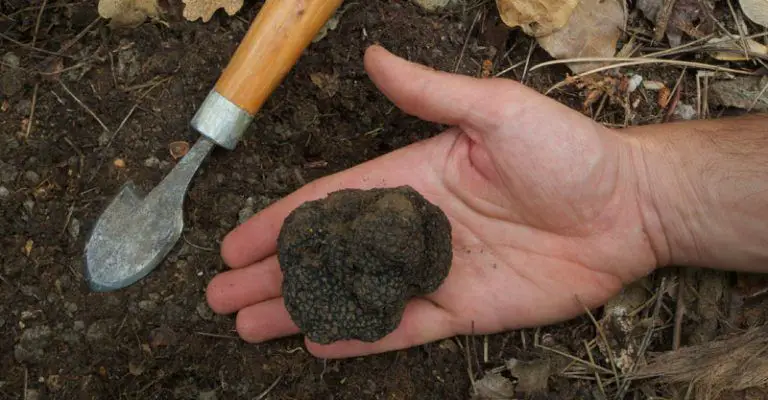
7 Varieties of Truffle Mushrooms that grow Underground
Table of Contents
Types of Mushrooms that grow underground (Truffle mushrooms Species)
The truffle, a mushroom that thrives beneath the soil in the form of a tuber, exists solely through a symbiotic relationship with the roots of select oak, linden, hazel, hornbeam, and poplar trees.
White truffles are an exquisite rarity, confined to specific environments characterized by clayey, moist, soft, calcium-rich soils near water sources. They flourish in areas with optimal air circulation and at particular elevations, typically between 400 and 1000 meters above sea level.
In scientific terms, truffles are classified within the Tuberaceae family, belonging to the genus of tubers and the class of ascomycetes.
Truffles boast the following chemical composition:
- Around 80% water content.
- Approximately 15% cellulose and fibers.
- Roughly 3% protein and fat.
- About 2% salt and phosphate.
- A mere 0.01% of essential oils, responsible for their distinct aroma.
Italians regard truffles as true “guardians of the environment,” intolerant of pollution.
Globally, there are 63 known varieties of truffle, with 34 originating from Europe and 25 found in Italy. However, only 9 are deemed edible, and among those, 7 are commonly found in markets.
The value of a truffle lies not in its taste, which is nearly neutral, but in its potent aroma, adored by some and disliked by others.
This intense and enduring fragrance, developed post-maturation, serves a natural function of attracting wild animals such as pigs, wild boars, badgers, and foxes. These animals aid in the dissemination of spores by digging, consuming, and dispersing them through their secretions, facilitating the fungus’s reproduction.
White truffle – Tuber magnatum Pico
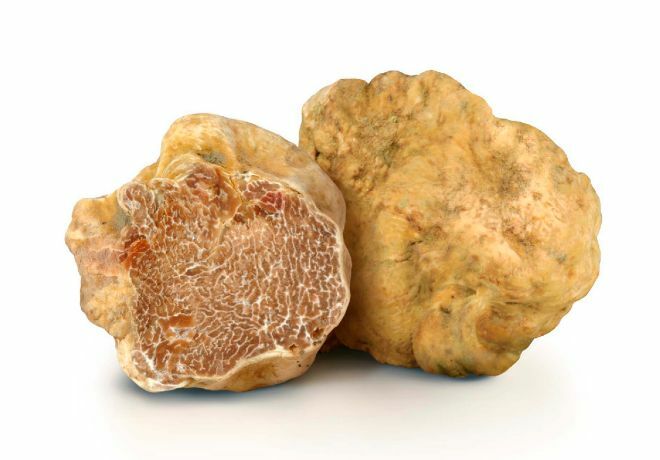
He’s the reason why prices soar to 2000-4000 euros per kilogram, earning it the moniker of the white truffle from Alba.
This coveted fungus stands as the world’s priciest truffle due to its exclusive habitat, found only in select regions of Croatia (Istria), Slovenia (Istria), Italy (Piedmont, Tuscany, Umbria), and occasionally in Switzerland (Canton of Ticino).
Attempts to cultivate it have been futile; it thrives solely in the wild.
Harvest season spans from September to January, maturing as temperatures drop below 10°C.
Typically sized between 2 to 6 cm, occasionally reaching up to 15 cm, it can weigh over 500 grams, though the average is around 20 grams.
Its smooth outer layer comes in hues of pale beige, yellow, or ocher, occasionally with a hint of olive green, but never grey.
Internally, the gleba may vary from whitish to yellowish-pink or ocher-brown, adorned with delicate white veins.
Renowned for its intense and intricate aroma reminiscent of aged cheese, garlic, shallots, and earthy tones, its scent is unforgettable. However, when cooked, its flavor dissipates, hence it’s exclusively enjoyed raw, grated over dishes like pasta, scrambled eggs, meat tartare, fondue, buttered tagliatelle, or risotto.
The first publication about the white truffle from Alba emerged in Milan in 1780, christening it Tuber magnatum Pico, with “Magnatum” denoting its allure for the affluent and “Pico” paying homage to Vittorio Pico, the pioneer in its scientific classification.
Piedmont hosts an annual charity auction for white truffles, where buyers from Asia, including Hong Kong, South Korea, and Singapore, have been known to shell out staggering sums, with some paying up to 105 thousand euros for hefty specimens weighing 850 grams or more.
black truffle: Tuber melanosporum Vitt
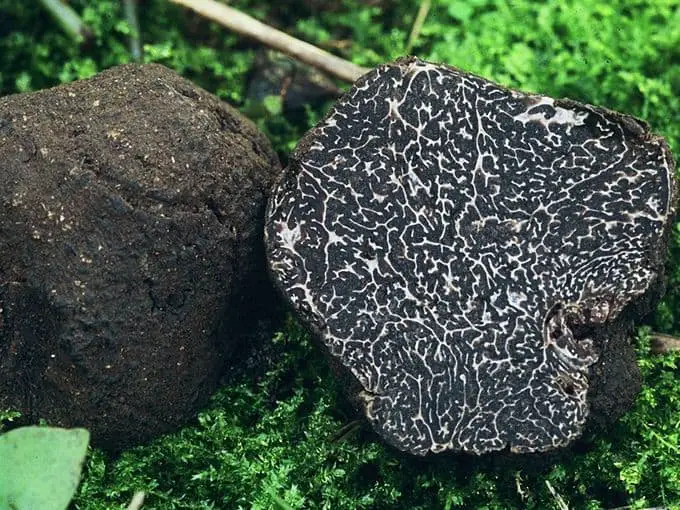
This particular variety stands out as the priciest among its black counterparts, fetching prices ranging from 1000 to 2000 euros per kilogram. Its allure in gastronomy is unparalleled, boasting a rich aroma reminiscent of dried fruits, moist soil, strawberries, and subtle hints of cocoa. Particularly esteemed in French cuisine, it enhances the flavors and fragrances of accompanying meat sauces.
Referred to as Perigord, French truffle, or winter black truffle, this delicacy owes its name to the meticulous studies of the Italian botanist and mycologist Carlo Vittadini (1800-1865). His comprehensive work “Monographia Tuberacearum” identified over 60 species, including 51 previously undocumented ones, hence prefixing the names of nearly all truffle varieties with ‘Vitt’ or ‘Vittadini’.
Harvested from November to mid-March, its exterior showcases a wrinkled peridium adorned with small polygonal warts, while its creamy gleba transitions into a black hue with purple undertones as it matures. Delicate white branched veins, turning reddish upon ripening or exposure to air, traverse its interior, darkening when cooked. With a fleshy, compact texture, it emits an intense, unmistakable aroma and offers a soft, subtly sweet, slightly bitter taste.
This versatile mushroom can be incorporated both cooked and raw into various dishes. Despite centuries of attempts to cultivate Tuber melanosporum Vitt., its true success was realized in France circa 1810, followed by Italy in the early 20th century. However, stable cultivation has only been achieved in the past 25 years in both countries, with ongoing efforts now extending to the United States and New Zealand.
Black summer truffle Tuber aestivum Vitt (Vittadini)
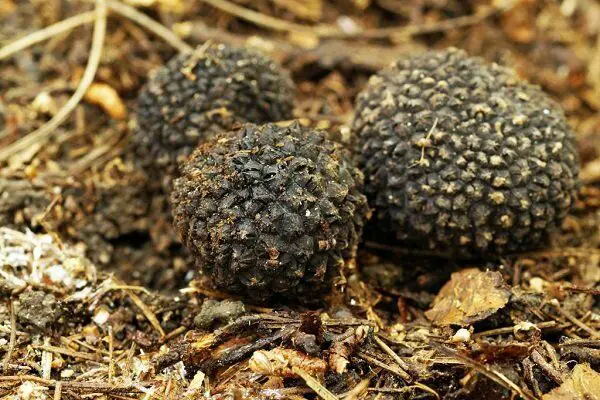
Also recognized as the Scorzone truffle in Italy, the summer truffle commands prices ranging from 80 to 450 euros per kilogram, contingent upon factors such as size, quality, and the time of harvest.
While many truffle-based products like sauces, spreads, pâtés, and butter predominantly feature the summer black truffle due to its agreeable flavor profile when cooked, a curious distinction arises in France. Here, the economical black truffle is dubbed the “White summer truffle” (blanche d’été) in French, owing to its pale interior, despite its external black hue.
This species, ubiquitous across Europe from Portugal to Russia and from Sweden to Italy, flourishes in numerous countries, including Portugal, Spain, Ireland, France, Great Britain, Belgium, Holland, Germany, Denmark, Sweden, Lithuania, Poland, Russia, Czech Republic, Slovakia, Ukraine, Bulgaria, Hungary, Romania, Serbia, Turkey, Austria, Switzerland, and non-EU nations like Morocco and Korea.
In Italy, it spans 16 out of 20 regions, thriving in Piedmont, Liguria, Lombardy, Veneto, Trentino, Emilia-Romagna, Tuscany, Marche, Umbria, Lazio, Abruzzo, Molise, Campania, Basilicata, Sicily, and Sardinia.
This esteemed black truffle boasts exceptional culinary attributes and is frequently employed in preserved forms such as truffle paste, truffle honey, and whole truffles in brine, with some specimens attaining weights of up to 700 grams. Its aroma evokes the essence of the forest, offering a rich and enticing sensory experience.
Characterized by a blackish-brown peridium adorned with prominent pyramidal warts, and a walnut or light brown gleba with delicate white veins, the summer truffle is harvested from May 1 to November 30.
Organized cultivation efforts for Tuber aestivum Vitt. commenced in France in 1973, while Tuscany stands out as a prime region in Italy for the cultivation of summer truffles.
whitebait or marzuolo (Bianchetto White Truffle) Tuber Borchii Vitt or Tuber Albidum Pico
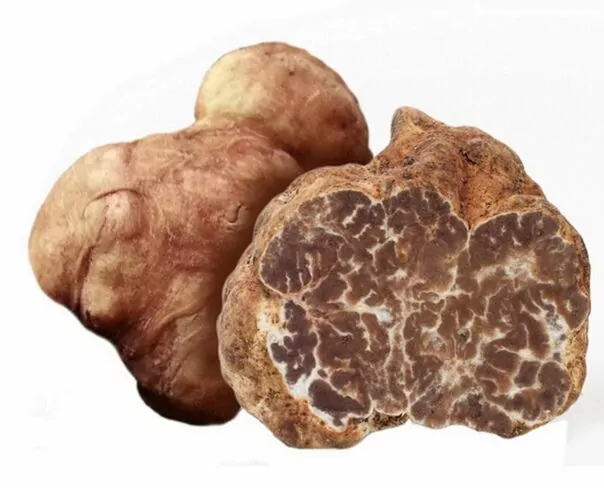
Resembling the renowned white truffle Magnatum Pico in both taste and appearance, albeit with a milder aroma and flavor profile. Its scent carries a subtle hint of garlic. Ideal forcomplementing various game meats such as hare, pheasant, woodcock, and wild boar.
Pricing ranges from 100 to 250 euros per kilogram.
This truffle, known as Marzuolo or Bianchetto (whitish) in Italy, is harvested from January 15 to April 30 across the country.
Unlike its counterparts, Bianchetto boasts a smooth, pale skin ranging from ocher to reddish hues, indicative of its maturity and the soil it thrives in. Its interior is light, transitioning to brown with prominent white streaks, initially whitish in youth and reddening as it matures.
Characterized by a rounded shape, Bianchetto typically measures akin to a hazelnut or slightly larger, though occasionally growing to the size of a chicken egg.
Its distribution extends across various countries, including Spain, France, Great Britain (particularly Southwest England), Ireland, Belgium, the Netherlands, Germany, Denmark, Finland, Poland, the Czech Republic, Slovakia, Hungary, Croatia, Austria, Switzerland, China, and the USA. Moreover, cultivation in nurseries and forest plantations has been successfully implemented.
Black Autumn Truffle- Tuber Uncinatum Chatin
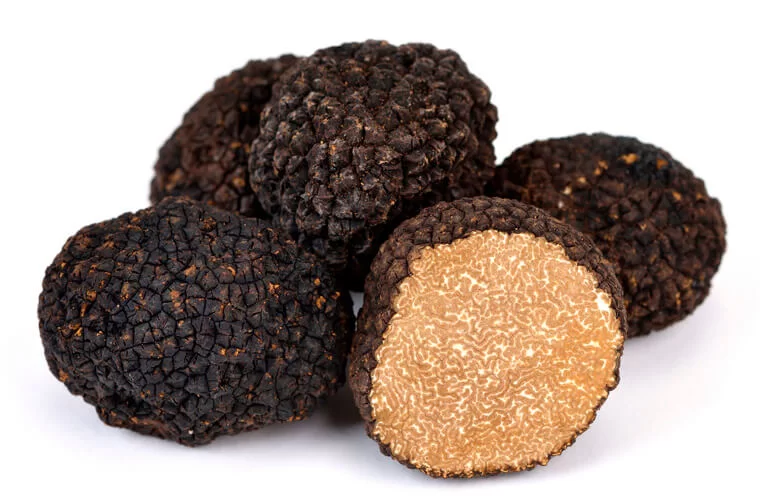
This esteemed delicacy, cherished in France, goes by the name of the “Burgundy truffle.” Renowned for its delicate aroma and rich flavor, it is a preferred choice for culinary endeavors. In recent years, chefs from various regions have increasingly embraced this variety.
Priced at approximately 250-500 euros per kilogram, its value varies depending on size. Ripening from October to January, it thrives in the cold winter climate, evading the threat of flies and insects.
Distinctively, its aroma carries a slightly fruity essence, more robust and pleasant compared to the summer black truffle. Its black peridium boasts fewer visible warts than its summer counterpart, while the gleba exhibits a dark chocolate brown hue with white streaks. Typically rounded, occasionally irregular, its size tends to be smaller than the black summer truffle.
In culinary applications, it is shaved onto fillets, incorporated into cheese fondue, added to omelettes, eggs, and tagliatelle pasta. French chefs commonly sauté it in butter with garlic, salt, and pepper.
Originating primarily in France, particularly in Burgundy, Champagne, Lorraine, and Franche-Comte, as well as Italy, it is also cultivated to meet demand.
Smooth black truffle – Tuber Macrosporum Vitt
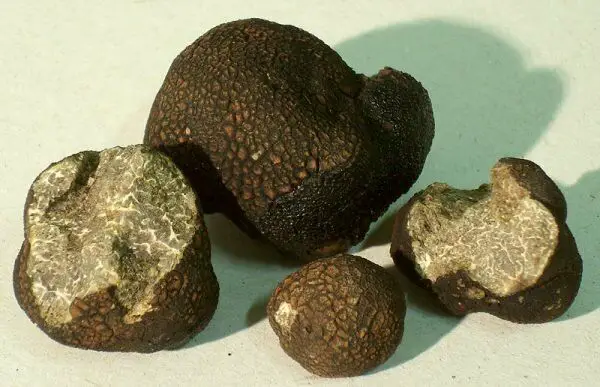
The lesser-known Macrosporum truffle is a hidden gem in the culinary world. Despite its lower popularity, it boasts a delightful garlic aroma and flavor complemented by subtle notes of roasted barley, reminiscent of the prized white Magnatum Pico truffle. Thriving in the same soil and symbiotically connected to the same trees as the Magnatum Pico, it shares a similar fragrance profile.
Identifiable by its large spores and flattened warts, the Macrosporum truffle is sometimes almost smooth, earning it the moniker “smooth black truffle”. With prices ranging from 200 to 500 euros per kilogram, it’s a delicacy worth savoring.
Measuring between 2 to 5 centimeters in diameter, this truffle is typically harvested from September 1st to December 31st. Its culinary versatility shines in the production of sauces and pastes.
Found across various European countries such as France, Great Britain, Germany, the Czech Republic, Switzerland, Serbia, Romania, and Ukraine, it’s particularly abundant in Italy. Regions like Piedmont, Lombardy, Veneto, Liguria, Emilia-Romagna, Tuscany, Marche, Umbria, and Lazio boast its presence.
The Macrosporum truffle’s gleba is characterized by its dense, hard texture, transitioning to a brown-purple-black hue when mature, adorned with wide sinuous veins marbling the surface.
black winter truffle – Tuber Brumale Vittadini
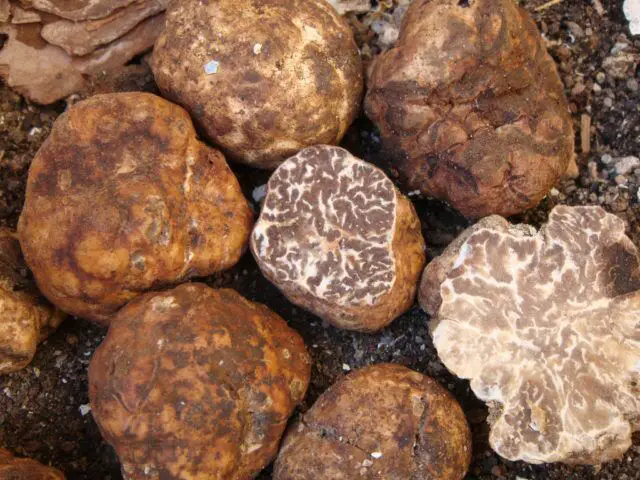
This truffle, also known as the “musk truffle” (its primary variant being moschatum), thrives in environments akin to the coveted black Melanosporum, flourishing during the same season.
Its season spans from late December to early March, and typically, it doesn’t surpass the size of a chicken egg. Unlike the esteemed Melanosporum, its black exterior lacks any red reflections and readily comes off with brushing.
The gleba of this truffle starts off dense and firm, initially white, transitioning to grey-brown or grey-black as it matures, adorned with sporadic broad white veins that maintain their hue upon exposure. While Brumales may display more numerous and finer veins, they can be distinguished from Tuber melanosporum by the perpetually white veins on a Brumale.
Its scent is robust and pleasant, reminiscent of Tuber melanosporum, with musky undertones evoking fermented fruits, yeast, and hints of nuts and hazelnuts.
Conclusion
Mushrooms that grow underground, particularly truffle mushrooms, offer a glimpse into the fascinating world of mycology and culinary artistry. From the prized white truffle to the versatile black summer truffle, each variety brings its own unique characteristics to the table. Whether enjoyed by gastronomic connoisseurs or adventurous home cooks, truffles continue to captivate with their elusive charm and unparalleled flavor.
#TruffleMushrooms #CulinaryDelights #GourmetFood #Mycology #TruffleHunting #FineDining #FoodieFinds #Gastronomy #UndergroundMushrooms #FarmToTable
